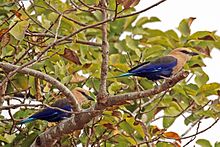The blue-bellied roller (Coracias cyanogaster) is a member of the roller family of birds which breeds across Africa in a narrow belt from Senegal to northeast Democratic Republic of the Congo. It is resident, apart from some local seasonal movements, in mature moist savannah dominated by Isoberlinia trees.
| Blue-bellied roller | |
|---|---|

| |
| Pair in The Gambia | |
| Scientific classification | |
| Domain: | Eukaryota |
| Kingdom: | Animalia |
| Phylum: | Chordata |
| Class: | Aves |
| Order: | Coraciiformes |
| Family: | Coraciidae |
| Genus: | Coracias |
| Species: | C. cyanogaster
|
| Binomial name | |
| Coracias cyanogaster Cuvier, 1816
| |

| |
| Geographic distribution shown in green | |
Taxonomy
editThe blue-bellied roller was given the binomial name Coracias cyanogaster in 1816 by the French naturalist Georges Cuvier based on "Le Rollier à ventre bleu" that had been described and illustrated by François Levaillant in 1806.[2][3] The specific epithet combines the Ancient Greek kuanos meaning "dark-blue" with gastēr meaning "belly".[4] Levaillant mistaken believed that the specimen had been collected on the island of Java.[3] The species is resident in West-Africa and the type location was later designated as Senegal.[5] The species is monotypic: no subspecies are recognised.[6]
The phylogenetic relationships among the Coracias species are shown below, from the molecular study by Johansson et al. (2018)[7]
| Coracias |
| ||||||||||||||||||||||||||||||||||||||||||||||||
Description
editThe blue-bellied roller is a large bird, nearly the size of a jackdaw at 28–30 cm (11–12 in). It has a very dark brown back, buffy or chalky white head, neck and breast, with the rest of the plumage mainly blue. Adults have 6 cm (2.4 in) tail streamers. Sexes are similar, but the juvenile is a drabber version of the adult.[8]
The blue-bellied roller is striking in its strong direct flight, with the brilliant blues of the wings contrasting with the dark back and cream colored head, and the tail streamers trailing behind.[8]
The call of blue-bellied roller is a harsh clicking ga-ga-ga sound.[8]
Distribution and habitat
editThis is a common bird of warm open country with some trees. These rollers often perch prominently on trees, posts, or overhead wires, like giant shrikes, whilst watching for the grasshoppers and other large insects on which they feed.
Behaviour and ecology
editThe display of this bird is a lapwing-like display, with the twists and turns that give this species its English name. It nests in a hole in a tree - a tree cavity.
Status
editWidespread and common throughout its large range, the blue-bellied roller is evaluated as Least Concern on the IUCN Red List of Threatened Species.[1]
In captivity
editThe blue-bellied roller is kept in some zoos, open air aviaries and similar educational facilities. There are instances of the bird escaping captivity and adjusting to the local environment. In Nepalganj area of Joka, Kolkata, two blue-bellied rollers have been spotted since May 2023 that have adapted to the local environment.[9][10]
References
edit- ^ Jump up to: a b BirdLife International (2016). "Coracias cyanogaster". IUCN Red List of Threatened Species. 2016: e.T22682908A92967763. doi:10.2305/IUCN.UK.2016-3.RLTS.T22682908A92967763.en. Retrieved 19 November 2021.
- ^ Cuvier, Georges (1817). Le Règne animal distribué d'après son organisation : pour servir de base a l'histoire naturelle des animaux et d'introduction a l'anatomie comparée (in French). Vol. Tome 1. Paris: Déterville. p. 401, Note 2. The volume has 1817 printed on the title page but was published in 1816. See: Dickinson, E.C.; Overstreet, L.K.; Dowsett, R.J.; Bruce, M.D. (2011). Priority! The Dating of Scientific Names in Ornithology: a Directory to the literature and its reviewers. Northampton, UK: Aves Press. p. 85. ISBN 978-0-9568611-1-5.
- ^ Jump up to: a b Levaillant, François (1806). Histoire naturelle des oiseaux de paradis et des rolliers : suivie de celle des toucans et des barbus (in French). Vol. Tome Premier. Paris: Chez Denné le jeune, Perlet. pp. 78–79 Plate 26.
- ^ Jobling, James A. (2010). The Helm Dictionary of Scientific Bird Names. London: Christopher Helm. p. 127. ISBN 978-1-4081-2501-4.
- ^ Peters, James Lee, ed. (1945). Check-List of Birds of the World. Vol. 5. Cambridge, Massachusetts: Harvard University Press. p. 244.
- ^ Gill, Frank; Donsker, David; Rasmussen, Pamela, eds. (January 2021). "Rollers, ground rollers, kingfishers". IOC World Bird List Version 11.1. International Ornithologists' Union. Retrieved 27 April 2021.
- ^ Johansson, U. S.; Irestedt, M.; Qu, Y.; Ericson, P. G. P. (2018). "Phylogenetic relationships of rollers (Coraciidae) based on complete mitochondrial genomes and fifteen nuclear genes". Molecular Phylogenetics and Evolution. 126: 17–22. doi:10.1016/j.ympev.2018.03.030. PMID 29631051. S2CID 5011292.
- ^ Jump up to: a b c Fry, C. Hilary; Fry, Kathie; Harris, Alan (1992). Kingfishers, Bee-eaters, and Rollers. London: Christopher Helm. pp. 300–301, Plate 39. ISBN 978-0-7136-8028-7.
- ^ Niyogi, S. (2023). "W African bird spotted 8k km away in Baruipur". Times of India. Retrieved 17 October 2023.
- ^ Datta, R. (2023). "African cousin of Durga's Neelkontho bird set to call Kolkata home". The Telegraph India. Retrieved 17 October 2023.
External links
editMedia related to Coracias cyanogaster at Wikimedia Commons
